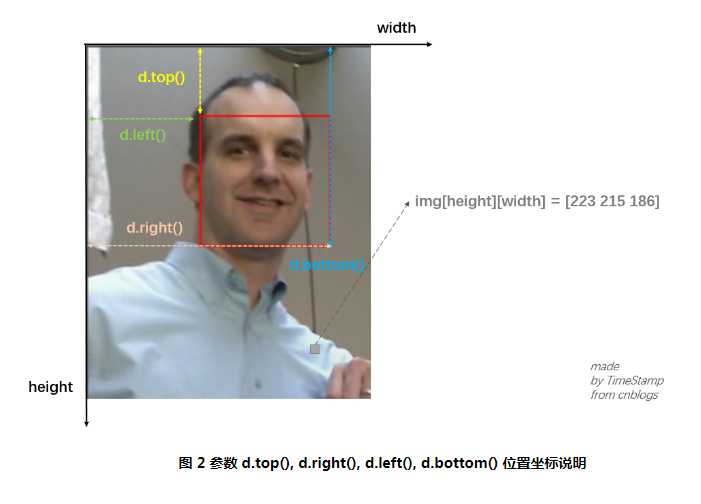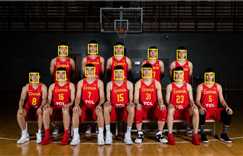标签:绘制矩形 输入 部分 lib open key 友好 需要 自己的
本小节解读官网example
a. 这个例子展示了如何在一个图像中找到正面的人脸。具体来说,它显示了如何从命令行获取图像列表,并在屏幕上显示每个带有红框的人脸。
b. Face_detector采用了HOG特征,结合了线性分类器、图像金字塔和滑动窗口检测方案。这种类型的目标检测是非常普遍的,且有能力检测除人脸外许多半刚性目标。因此,如果你对制作你自己的目标检测感兴趣,那么可以阅读train_object_detector.py文件
# -*-coding:utf-8-*- #author: lyp time: 2018/9/7 import sys import dlib # 初始化程序 detector = dlib.get_frontal_face_detector() win = dlib.image_window() # 读取图片,在cmd中键入 python xx(文件名).py 需要识别的图片名 for f in sys.argv[1:]: print("Processing file: {}".format(f)) img = dlib.load_rgb_image(f) # 参数1表示我们对图像进行向上采样1倍,这将使一切变的更大 # 进而让我们检测出更多的人脸 dets = detector(img, 1) # 输出检测出来的人脸个数 print("Number of faces detected: {}".format(len(dets))) # 输出第i张人脸矩形框的位置坐标,详情见下图1 for i, d in enumerate(dets): print("Detection {}: Left: {} Top: {} Right: {} Bottom: {}".format( i, d.left(), d.top(), d.right(), d.bottom())) # 绘制人脸矩形轮廓 win.clear_overlay() win.set_image(img) win.add_overlay(dets) # 等待点击 dlib.hit_enter_to_continue() # 下面这部分的功能是输出第i张人脸的得分 # score分数越大,说明detector更确信是人脸 # detector.run中第三个参数是可选择的检测阈值 # 检测阈值为负,将会返回更多的检测结果 # 检测阈值为正,将会返回较少的检测结果 # idx将告诉我们是哪个子检测器与图像中第i张人脸匹配。 # 这将更广泛地用于识别不同方向的人脸 if (len(sys.argv[1:]) > 0): img = dlib.load_rgb_image(sys.argv[1]) dets, scores, idx = detector.run(img, 1, -1) for i, d in enumerate(dets): print("Detection {}, score: {}, face_type:{}".format( d, scores[i], idx[i]))

a.官网例子需要再windows下的cmd中输入命令运行程序,具体原因与操作可以参考:XXXXXX。
这种操作在Windows中非常不友好,各种奇怪的问题。所以,需要更换读取图片的方式
b.我们常用OpenCV处理,下面小节改成OpenCV操作图片。
3. 换为OpenCV后的代码
# -*-coding:utf-8-*- #author: lyp time: 2018/9/7 import cv2 import dlib # 初始化程序 detector = dlib.get_frontal_face_detector() # 读取图片,在cmd中键入 python xx(文件名).py 需要识别的图片名 img = cv2.imread("cba.jpg") # 参数1表示我们对图像进行向上采样1倍,这将使一切变的更大 # 进而让我们检测出更多的人脸 dets = detector(img, 1) # 输出检测出来的人脸个数 print("Number of faces detected: {}".format(len(dets))) # 输出第i张人脸矩形框的位置坐标,详情见下图1 for i, d in enumerate(dets): print("Detection {}: Left: {} Top: {} Right: {} Bottom: {}".format( i, d.left(), d.top(), d.right(), d.bottom())) cv2.rectangle(img, tuple([d.left(), d.top()]), tuple([d.right(), d.bottom()]), (0,255, 255),2) # cv2.rectangle(img, pt1, pt2, color, thickness=None, lineType=None, shift=None):绘制矩形框图 # img: 输入的图像 # pt1: 矩形顶点坐标 # pt2: 与pt1成对角的顶点坐标 # color: 矩形框的颜色 # 2: 所画线的宽度 # 绘制人脸矩形轮廓 cv2.imshow("img", img) cv2.waitKey() cv2.destroyAllWindows() # 下面这部分的功能是输出第i张人脸的得分 # score分数越大,说明detector更确信是人脸 # detector.run中第三个参数是可选择的检测阈值 # 检测阈值为负,将会返回更多的检测结果 # 检测阈值为正,将会返回较少的检测结果 # idx将告诉我们是哪个子检测器与图像中第i张人脸匹配。 # 这将更广泛地用于识别不同方向的人脸 dets, scores, idx = detector.run(img, 1, -1) for i, d in enumerate(dets): print("Detection {}, score: {}, face_type:{}".format( d, scores[i], idx[i]))

4.致谢
https://www.cnblogs.com/AdaminXie/p/7905888.html
【人脸检测——Dlib学习】Face_detector_example
标签:绘制矩形 输入 部分 lib open key 友好 需要 自己的
原文地址:https://www.cnblogs.com/gfgwxw/p/9605773.html